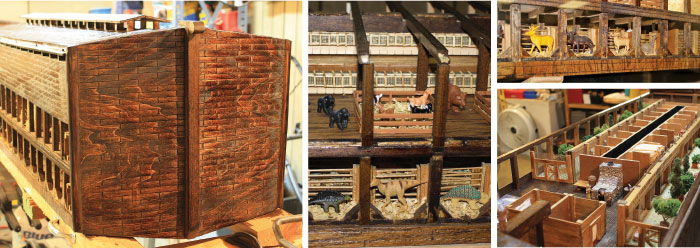On January 7, 2015, I delivered my model of Noah’s Ark to our Institute for Creation Research offices in Dallas, Texas. The project started as part of my Master’s in Christian Education at the ICR School of Biblical Apologetics (SOBA), but the idea came to me in the middle of the night in March 2010. Like Noah, God gave me a vision, and while I wasn’t given every detail, I did receive a sense of urgency to accomplish the task.
I intended to donate the project to ICR from the very beginning, which motivated me to strive for excellence in its construction. Except for the nautical experience I picked up in the twelve years I spent in the U.S. Navy, I brought no special building skills to the project—I didn’t even have the tools. I trusted God to provide the vision, imagination, resources, and skill necessary to complete the Ark. He taught me as I applied my hand to the task—I give all the glory to Him.
As the task progressed, however, I realized it would not be finished in time for my November 2011 graduation. I wrote a thesis instead. But that did not assuage my desire to complete the model and make good on my promise.
On January 8, 2015, the ICR staff gathered around the Ark for a time of dedication. My prayer is that God will use the model as an effective teaching tool to remove the Ark’s mythical stigma, give life to the Genesis Flood account, and remove any doubt of the truth of God’s Word.
The Ark, according to the biblical description and based on an 18-inch cubit, was a massive barge 450 feet long, 75 feet wide, and 45 feet high—a perfect seaworthy design. Because of my naval training, I knew I needed a fore and aft, a bow (stem) and a stern, and a port and starboard to keep myself orientated while constructing the model. But the Ark itself had no bow or stern, as it was not designed to sail. All it had to do was float and survive the catastrophic Flood.
Like Noah, I received a vision to create a tangible object lesson demonstrating not only the feasibility of such a phenomenal vessel, but to teach that even in His judgment, God is merciful and He provides the path to salvation.
Ark Model Facts and Features
- Completion time: 4.75 years / 1,379 hours / 574 days / 172.4 8-hour days
- Scale: 1/60, comparable to S-gauge 1/64 scale railroad model
- Inside dimensions: length 90" (7.5 feet), width 15", height 9"
-
Water storage:
— 6 cisterns, 2 per deck located at opposite ends of the ark
— 37,361 gallons x 6 cisterns = 224,166 gallons total capacity
— Replenishment: Following the 40 days of continuous rain, periodic rains would refill their stores via piping water from the roof into the cisterns. -
Grain storage:
— 2 grain storage silos fore and aft
— Between 2nd-story deck and 1st-story deck
— Volume: 10,526 bushels of grain at 52 lb./bushel = 547,352 lb. or 274 Tons -
Human passengers:
— 8 (4 men, 4 women)
— The figures on the model are ~ 1 1/8" tall; x 60 would make them 6'6" - 1st-story deck houses the large animals—reptiles and mammals
- 2nd-story deck houses the “clean” animals and features small animal cages
-
3rd-story deck features:
— The small roof above the main roof is the ventilation exhaust flue, the window mentioned in Genesis 6:16.
— Below the main roof at the top of the hull is the fresh-air intake that runs the length of the Ark from port to starboard.
— The forward section is open for viewing and features aviaries, port and starboard, sleeping quarters, a family area, a work area, stone oven, and storage rooms.
— Fill ports for the grain silos are located at the forward end next to the cistern.
* Mr. Carrasco is an Instructor at the ICR School of Biblical Apologetics.













